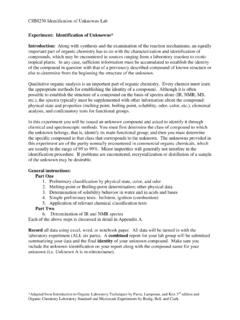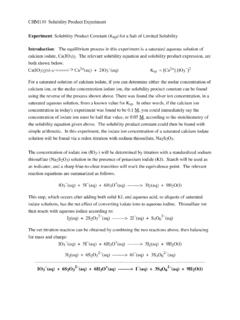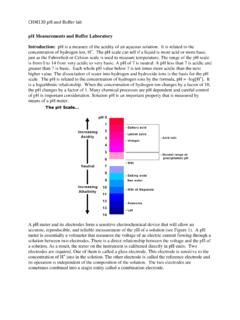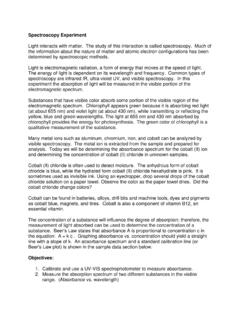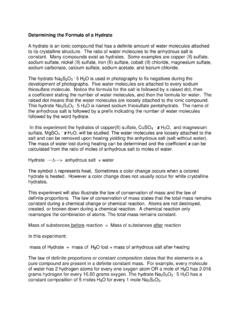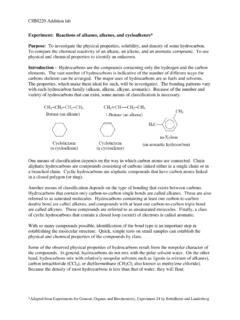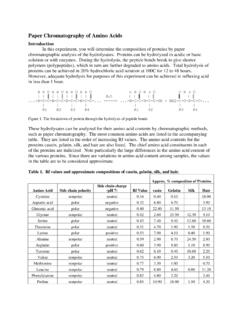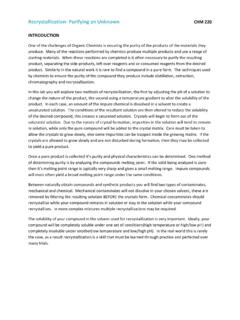Transcription of Determination of Caffeine in Beverages
1 CHM250 HPLC-1 LAB Determination of Caffeine in Beverages Introduction This experiment provides an introduction to the application of High Performance Liquid Chromatography (HPLC) to the solution of complex analytical problems. Cola type drinks, coffee, and tea all are complex chemical systems that contain varying amounts of Caffeine . The amount of Caffeine present in these Beverages can be determined by HPLC. An isocratic HPLC using a reverse phase C18 column is used in this experiment. The mobile phase is 50% by volume methanol in water prepared from ultra-pure water and HPLC grade methanol containing 1% acetic acid.
2 With the instrument that is being used, it is not necessary to degas the water or the methanol. Care should be taken not to aerate solutions when pouring them. The beverage samples will be filtered to remove any insoluble material. In reverse phase HPLC the mobile phase is polar and the stationary phase in non-polar. When a sample is injected into the instrument, the mobile phase moves it through the column. Molecules in the sample that are polar interact more strongly with the mobile phase and elute from the column first.
3 Non-polar molecules interact more strongly with the stationary phase and elute from the column last. As molecules elute from the column, they are detected, and a peak is recorded in chromatogram. The identity of a peak can be found by comparing its retention time (the time that it eluted from the column) to the retention time of known compounds. Identical substances will have identical retention times. The area of the peak is also important as peak area is proportional to the concentration of that particular species in the sample.
4 Purpose To determine the amount of Caffeine in various Beverages . Materials Isocratic HPLC system Caffeine standards (50, 100, 150, 200 ppm) 254 nm UV detector 50:50 Methanol:water C18 column Ultra-pure or HPLC grade water HPLC grade methanol 25 50 L syringe Caffeine stock solution - 1000 ppm m syringe filters with 5 mL syringes or Funnels with #5 filter paper Beverage samples Small beakers Small vials Disposable pipettes Balance CHM250 HPLC-1 LAB Procedure Preparation of samples 1.
5 Obtain 1-2 beverage samples. 2. For soda samples, degas the sample by placing it in a vacuum flask and connecting the flask to a vacuum pump or water aspirator. Keep it under vacuum until no more bubbles appear in the soda sample. (If no vacuum is available, allow the soda to stand open overnight or place in a sonicator bath). 3. For instant powder Beverages , prepare as indicated on the package for a normal serving using the methanol/water solution instead of just water. Any insoluble material will be removed in the filtering step.
6 4. Filter the beverage sample through a m syringe filter with a 5mL syringe or use a #5 filter paper with gravity filtration. Transfer the filtered solution into a sample vial. Preparation of Caffeine standards 1. Prepare a 1000 ppm stock solution of Caffeine in 1 liter of water. 1. Prepare the following solutions from the 1000 ppm stock solution using 250mL or 100mLvolumetric glassware. Caffeine Stock Solution mL 1000 ppm stock solution Dilute to volume with 50:50 Methanol Water Caffeine (mg/L) [ppm] 1 50 2 100 3 150 4 200 2.
7 Use a pipette to deliver the stock solution to the volumetric flask and dilute to the final mass with the methanol/water solution. At the instrument: 1. Aliquots consisting of 25- L of the standards or samples should be injected. 2. Switch the manual injector to the load position and push at least three 25- l volumes of each sample through the sample loop, making certain each volume does not contain air bubbles. 3. With the syringe still in the injector, turn to the inject position, at which time the instrument will automatically start data acquisition.
8 Leave the injector in the inject position, and remove the syringe. 4. Rinse the syringe with at least 3 volumes of the methanol/water solution, dispensing the rinses into the waste beaker. Clean the syringe by rinsing several times with the solution to be injected. With the injector lever in the LOAD position, inject the sample. 5. Beverages with a high Caffeine content need to be diluted. If the area of the Caffeine peak for a beverage sample is greater than the area of the Caffeine peak for the 200 ppm CHM250 HPLC-1 LAB standard, dilute the beverage sample with the methanol/water solution and run again.
9 Start with a 1:1 dilution or 1:10 dilution. Results 1. Use the Caffeine standards to identify the Caffeine peak. 2. Record the retention time and area of the Caffeine peak for each of the standards. The peak area will increase from the lowest standard to the highest. 3. Use the retention time of the Caffeine peak to determine if Caffeine is present in the beverage samples. 4. If Caffeine is present in a beverage sample, record the retention time and area of the Caffeine peak and then calculate the Caffeine content based on the calibration curve.
10 Analysis of data 1. Using the data obtained for the standard solutions, prepare a calibration curve by graphing peak area versus concentration of Caffeine . 2. Use the calibration curve to determine the amount of Caffeine in your samples. Suggested unit are ppm, mg/mL, and/or mg/serving. 3. Use Table 1 to calculate the percent difference (error) between the results obtained in this experiment and the approximate amount of Caffeine in your selected beverage. Questions to answer in you Lab report, either in the introduction, discussion, or results section.
